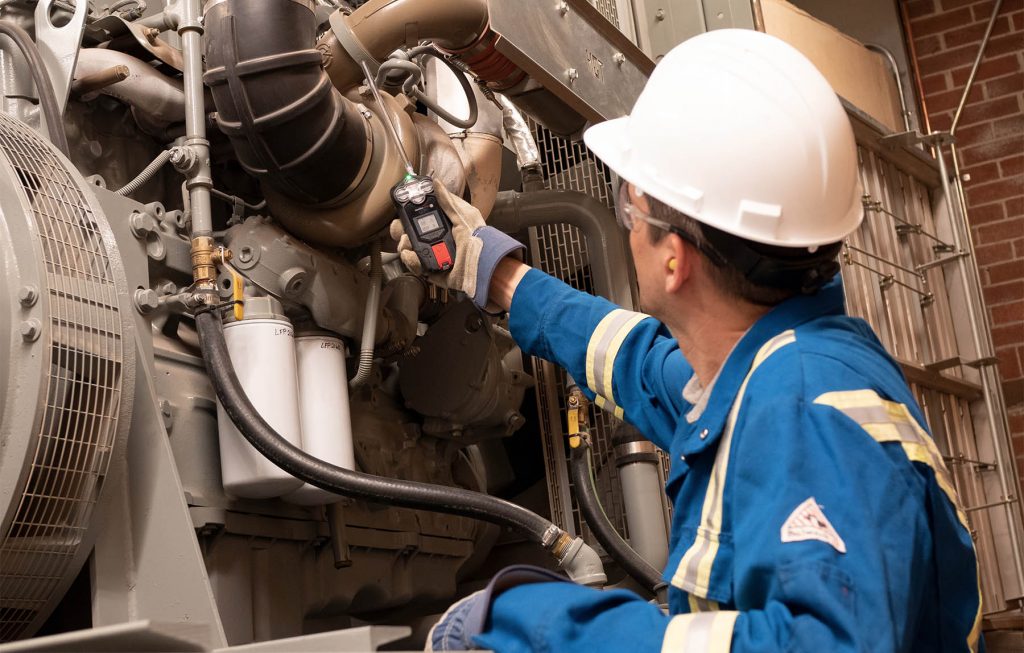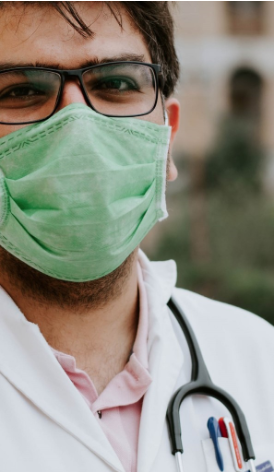Protecting the safety of your teams and worksite is a top priority. That’s why it is essential to use industry-leading connected safety technology to help safeguard your employees and businesses through automated industrial contact tracing.
Using a combination of Blackline Safety’s intrinsically safe G7 safety wearables and their Loner Mobile smartphone app, employee location data streams to the Blackline Safety Cloud and powers interactive contact tracing reports though an online Blackline Analytics software.

Should an employee present with symptoms or test positive for the COVID-19 virus, the contact tracing report can immediately retrace the individual’s steps, see where he or she may have had contact with other coworkers and see who those individuals are.
Blackline’s technology is designed for use on hazardous sites, and their intrinsically safe G7 wearables and Loner Mobile smartphone app can help reduce workers’ exposure and limit the spread of COVID-19.
HOW DOES COVID-19 SPREAD?
Understanding the transmission of COVID-19 is an ongoing process for medical professionals. Currently, it is understood that person-to-person transmission occurs through droplets expelled when an infected individual coughs, sneezes or speaks, notably when individuals are fewer than six feet (or two meters) apart from a sick individual. Other studies also show that some infected individuals may not present with symptoms, but still can transmit the virus through respiratory droplets. These individuals are known as asymptomatic carriers.
Transmission can also occur from contact with contaminated surfaces. COVID-19 can survive on surfaces for many hours or days depending on the material of the surface. To prevent transmission from contact with contaminated surfaces, wash your hands frequently with soap and water, and disinfect surfaces as often as deemed necessary.
LIMITING OR PREVENTING EXPOSURE WITH SOCIAL DISTANCING
According to the Center for Disease Control (CDC), the best way to prevent infection is to avoid exposure to the virus to the best of your ability. This is called social distancing (also known as physical distancing). The key is to limit contact with people outside your household, and to maintain a distance of at least six feet (or two meters) from people outside your household.
Current established best practices for social distancing include:
- Avoiding large gatherings and any close contact interactions with people outside your household (including friends and family you do not live with).
- Only leaving the home for essential trips, such as getting groceries or going to the pharmacy.
- Working from home.
When working from home is not a possibility, workers must ensure they maintain physical separation of at least six feet (or two meters) from all customers, clients and fellow employees.
What is contact tracing and how is it done?
Contact tracing is employed to understand and slow the rate of infection, discover and monitor potential cases, and introduce treatment and counselling procedures as soon as possible. Contact tracing is not new. It has been used in the management of numerous historical outbreaks, including smallpox, Ebola, various STIs and more.
Traditionally, public health officials conduct interviews with infected individuals to determine where the infected individual has been, when they were there, for how long, and who they were in contact with.
Interviewers rely on several memory aids to jog the individual’s memory because they are attempting to retrace a person’s complex movements over the past number of days or weeks. Some common memory aids are bank transactions, text message and email history, work records and receipts. While these are useful in jogging the infected individual’s memory, there is still the potential for significant gaps in the individual’s history.
What is technology’s role in contact tracing?
Given the emergence of location-enabled wearable technology, it should not be surprising that a person’s location history could be useful to improve the accuracy of contact tracing. One country that has had demonstrated success in using technology to aid in contact tracing is South Korea. As one of the first countries outside of China to experience a significant outbreak, South Korea quickly brought it under control using digital contact tracing techniques, including the use of GPS and CCTV.
With significant surveillance technology already in place, South Korea was able to track each person with a confirmed case of COVID-19, determine who they had interacted with, and notify the public of all the recent movements of someone with a case of COVID-19. Combined with rapid large-scale testing, societal norms around mask wearing and aggressive quarantining, South Korea successfully brought its outbreak under control. While successful in South Korea and several other nations, privacy legislation prevents many governments from instituting such large-scale digital contact tracing. In this case, we must adapt our available technology to augment traditional contact tracing techniques.
CURRENT INITIATIVES IN CONNECTED SAFETY
Apple and Google are partnering to develop an app that will use Bluetooth technology to notify a user when they have been in contact with an individual who has voluntarily self-identified as being infected with COVID-19.25 This initiative by Apple and Google could ease the pressure placed on public health officials by automating the process of contact tracing for infected individuals. While the app has faced criticism regarding privacy concerns, it could prove to be important in the global push to flatten the curve.
As planned, this app does not address two requirements of businesses. First, the app will not be functional on hazardous worksites where it is unsafe to carry a cell phone. Second, Apple and Google are proposing this as an “opt-in” tool, meaning that individuals will need to sign up for the service. Anyone who does not download the app will not be covered.
BLACKLINE SAFETY PRODUCTS AND CONNECTED SAFETY
Blackline Safety has leveraged the location technology in its safety wearables to bridge these gaps, delivering integrated digital contact tracing for the industrial workplace. Intrinsically safe, Blackline’s G7 wearables are already carried by tens of thousands of workers around the globe.
As your company adapts to the new realities of COVID-19, you will need tools to promote improved social distancing and to aid in contact tracing. Blackline offers two tools to support you in these efforts:
- Blackline Live History View
- Blackline Analytics Close Contact Report
Improving social distancing
As your employees and company are adjusting to newly written rules and procedures that promote social distancing, you will want to be able to monitor their success in implementing these measures. The Blackline Analytics Close Contact Report provides you with improved visibility to the frequency of close contact between individuals and areas on your facility where close contact is frequently occurring. You can use this report to identify potential super-spreaders and to spot high-contact areas.
Identifying potential super-spreaders
While most of your workforce may be taking social distancing measures seriously, there may be some individuals who are not taking the care required to maintain distance from their coworkers. The Close Contact Report provides you with a list of interactions for each worker, helping you proactively identify potential super-spreaders and implement corrective measures before they can place others at risk.
Identifying high-contact areas
Using the Close Contact Report’s heat map feature you can quickly identify the areas on your facility where close contact is most frequently occurring. This is a starting point for your investigative work. Once you have identified the potential trouble areas you will be able to assess those areas and implement corrective measures.
Conducting contact tracing investigations
In the unfortunate case that your company does experience a worker with COVID-19, quick action will help mitigate the potential spread of the virus. A contact tracing investigation is necessary to determine interactions the infected worker has had and locations they have visited. The World Health Organization currently estimates that the incubation period for COVID-19 is between 2 and 14 days. During this period, the worker may have been contagious.
The starting point of your close contact investigation will be to gather documentation. Work orders, emails, text messages and receipts will serve as memory aids in the investigation. Gather this documentation and begin to build a timeline of locations and activities for the worker. To help you improve the accuracy of the timeline and identify potential exposures, you can use the Blackline Live History View, and the Blackline Analytics Close Contact Report.
Blackline Live History View can be used to assist in recalling an employee’s movements. The slider control makes it easy to review chronological location data.
Using Blackline Live History View
If your company is using Blackline Safety’s connected safety products, authorized administrators in your business have access to your workers’ location history. Blackline’s devices automatically report a worker’s location to our cloud-based online portal, Blackline Live. This tool can be used as an additional memory aid when conducting contact tracing. Use the Blackline Live History View to review the past two weeks’ location history with the worker and document the people and places they interacted with. To find out how to access this tool, please see the FAQ.
Blackline Analytics Close Contact report can be used to find out which employee may have been at risk of exposure to COVID-19. The report can be customized for certain date ranges, distances and devices.
Using the Blackline Analytics Close Contact Report
The Blackline Analytics Close Contact Report generates a list of all other Blackline device users that the infected individual interacted with. If the location history of the infected worker shows a reported location with two meters of another worker, the Close Contact Report will generate a list of potential interactions. This is intended as an investigative tool rather than a definitive list. The results of this report are subject to the limitations of GPS and indoor location technology, which we discuss further in the FAQ section at the end of this document.
PRIVACY AND CONNECTED SAFETY
It is important to recognize the privacy rights of your worker when conducting your close contact investigation. Make sure you comply with the privacy laws of your jurisdiction and your company’s privacy policy. When discussing potential exposures with other employees or the public, do not reveal the identity of the employee with COVID-19. In many jurisdictions, public health authorities will inform people who may have been exposed without informing them of the source of the infection. This allows both your employee and the company to remain anonymous.
The fight against COVID-19 is an ever-changing landscape. Westech’s and Blackline’s customers have demonstrated their commitment to risk mitigation and proactive health and safety through their investment in Blackline’s technology. You can leverage the investment your company has made in safety to do your part in this fight, keeping your workers safe through proper social distancing and contact tracing.
To find out more about Westech Industrial’s Blackline Safety’s product and contact tracing please contact our Eastern Canada location at 1-800-775-6129 or visit our website at our Blackline Safety product page.
Share This:




 CDN NEWS |
CDN NEWS |  US NEWS
US NEWS 

































COMMENTARY: Where the Fight Against Energy Subsidies Stands – Alex Epstein